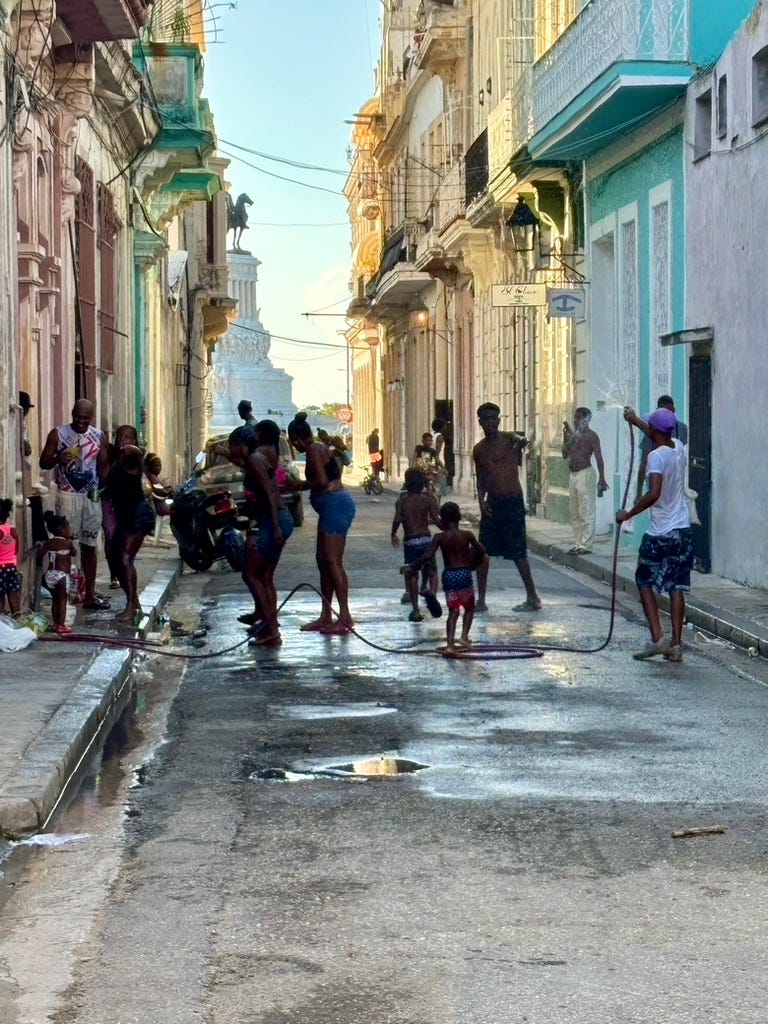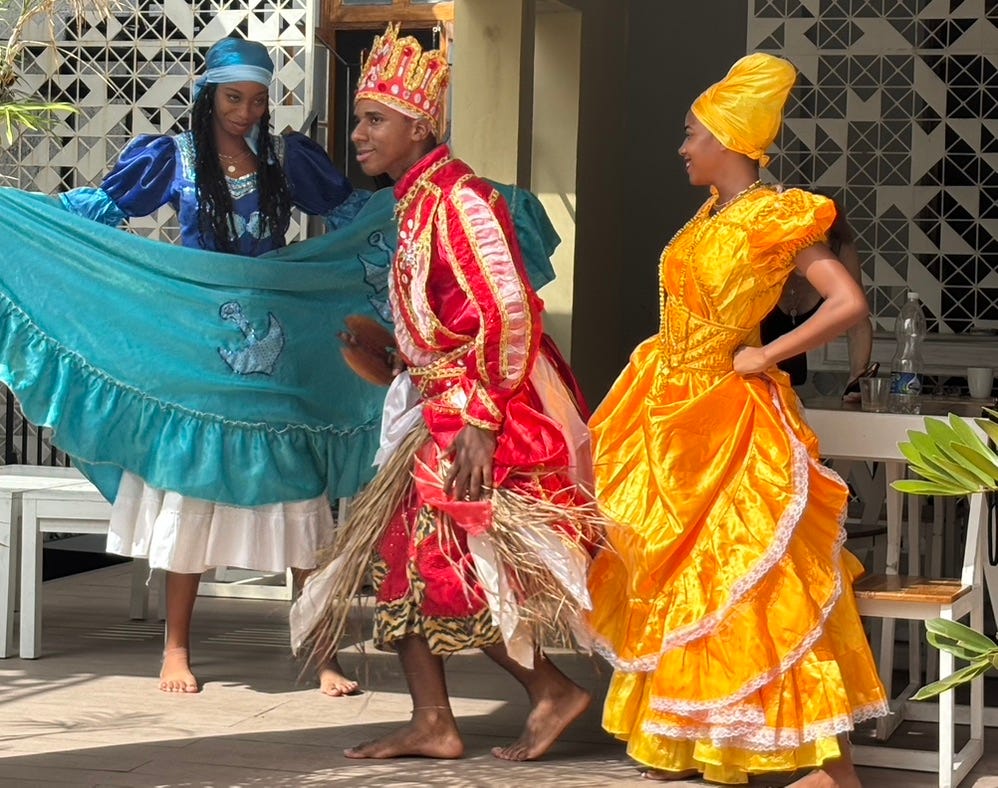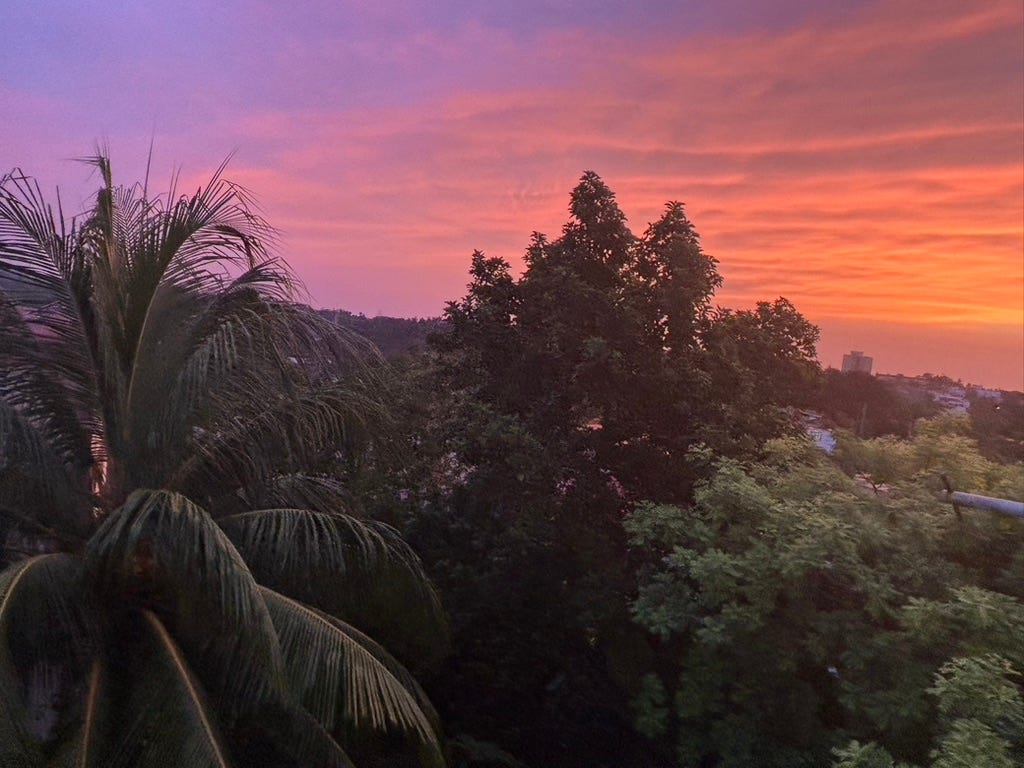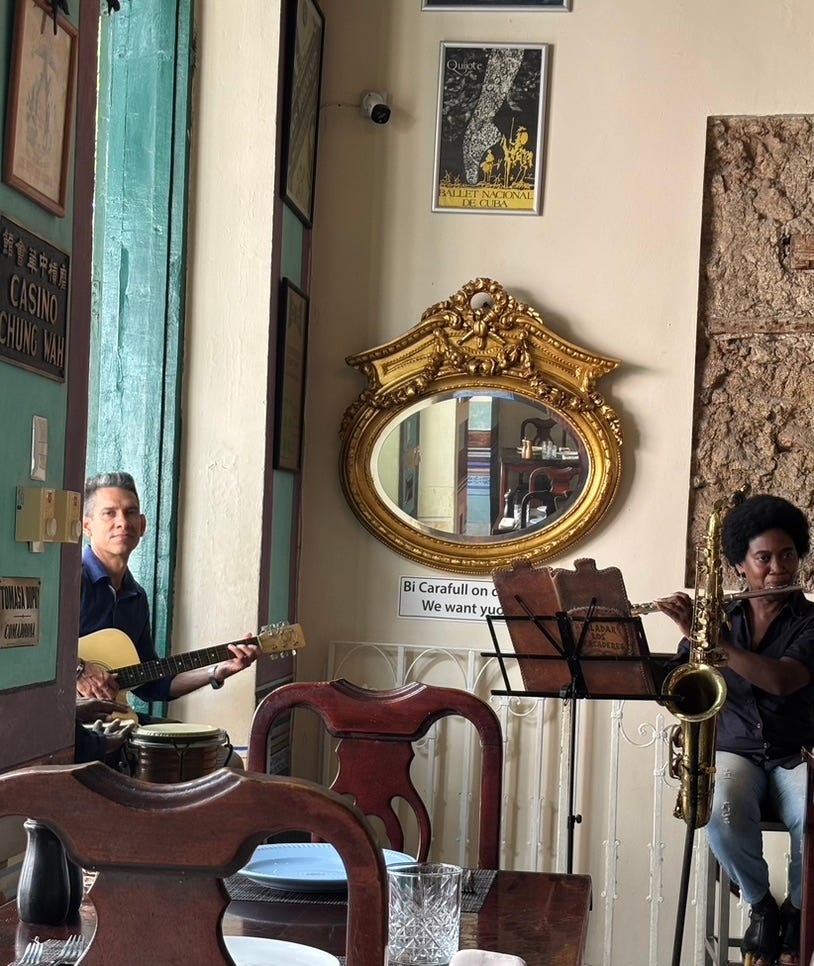I’m just back from an 8-day trip to Havana, Cuba. It was my third visit to that city, each time for a dance workshop. Cuba has the best music and dancers on the planet, I think, and I’m not alone in that opinion. It’s an incredible privilege to be able to go there and take classes with people who have music running through their veins. It seems like even the birds tweet the clave in Cuba.
It’s always difficult to go to Cuba, both preparing for the trip and being there—though it’s always not only worth it, but life-changing. It’s another world, one that western culture hasn’t completely infected: There are no stores with major brands, no cell phone coverage if you’re from the US, very little to buy, and spotty internet. Those may all sound like negatives—especially for the people who live there—but it felt like spending a vacation in the 1950s. Imagine not being able to doom-scroll all day long, and instead dancing for hours on end. Time slows down, you open your senses, and you feel the rhythm of the days and the music all around you.
This was my third trip to Cuba in the past eight years. Each has been memorable for the music on the streets and in restaurants, folkloric dance performances, and taking classes and going out dancing with ridiculously talented dancers. On my last trip was with San Francisco dance maestro Ramon Ramos Alayo, who almost single-handedly brought Cuban dance to the Bay Area and founded Cuba Caribe to share his dance traditions and keep them alive. He hired the best rumba band I’ve ever heard for a party on his rooftop, with all the neighbors dancing on adjoining rooftops and down in the streets. Another night, we had a pig roast with a DJ. No neighbors complain about loud music in Central Havana.
This trip was only eight people, mostly women, and we stayed in somewhat posher digs, a house in Havana Vieja where the electricity didn’t go out because most of the government buildings are in that neighborhood; others suffered electric outages of at least four hours a day or night (though Cuba has lots of sun, it is mostly powered by imported fossil fuels, with decaying infrastructure and no investment in the wind or solar power that would give them cheap and reliable electricity into the future). Our house also had air conditioning and a little pool on the roof, which were welcome luxuries in the humid heat of late June. I took three private dance classes a day, in hot and humid June, and was happy to come back, exhausted, and jump in the pool.
Outside our hotel in Havana Vieja, people cooled off with a hose.
Our house was one of those high-ceilinged, marble-floored mansions that are now mostly falling apart and decrepit because no one has any money to fix them up. Ours was renovated, because we were tourists. The difference between our privilege and the lives of the people living on our block was stark. The Cuban peso is worth less and less, while people’s wages haven’t gone up. Cubans rely a lot on tourism, which has dropped, particularly during this current US administration, which is universally reviled in Cuba. Last time I was in Cuba, I had lunch at San Cristobal, in Central Havana, where they hung the chair Obama sat in when he ate there on the wall. Now the Cubans I talked to nodded knowingly when I mentioned authoritarianism. They know what that looks like.
Compared with only a year and a half ago, the situation for most Cubans seemed worse. The Cuban peso was 345 to the dollar; in 2022 it was 25 pesos. We paid our restaurant checks in giant stacks of bills; the servers brought a cigar box with the check instead of a tray, and they always counted before we left. Everyone wanted dollars. Even more than that, because the electricity was always going out, everyone wanted a battery-backed electric fan, which, at about $90, was out of reach for most. When our group bought them for the two women who cooked and cleaned for us, who were always tired because they couldn’t sleep when the electricity went off at night, they cried. So little can do so much.
Folkloric dancers including our trip’s fixer, Fabi, danced for our group.
When you visit Cuba as a resident of the US, you have to apply for a visa, and check a reason for the trip; one is “support for the Cuban people.” Any tourism counts as support, but given the lack of almost anything there—medicine, clothing, personal hygiene items—packing an extra bag full of all the stuff we take for granted is the least you can do. For all its free medical care, there aren’t many things like antibiotics on the island, even if they’re prescribed. I left for Cuba from Mexico, where, while you need a prescription for antibiotics and pain meds, when I explained I was going to Cuba, the pharmacist handed over what she thought were the most essential medicines, and I also loaded up on ibuprofen, condoms, razors, shampoo, toothbrushes, deodorant, soap, power bars, and t-shirts for the dance teachers. I packed a bunch of clothes that I could leave behind (the house manager’s wife apparently was my size, even my breasts, he said, in that frank and relaxed way Cubans have about talking about bodies, so I left her most of my clothes and bras, which are nearly impossible to get there).
On the walk from our hotel to the dance studio we passed a lot of people hanging out on the street, one of whom, an elderly woman, was kind of like the mayor, keeping a watch on everyone, warning us away from money changers. She always asked for medicines and money. The first day I gave her a kit of personal hygiene items, antibiotics, ibuprofen, and other stuff. From that day on, everyone on the street asked me for medicine. I learned that the woman was selling the meds we gave her, and didn’t blame her, but I ended up giving the rest of my stash to my SF dance teacher’s sister, Enardys, who I knew would distribute them equitably. It’s a weird dynamic.
I contacted Enardys to invite her to dinner, but she invited me over instead. I went with Monica, one of my dear friends, who used to be a roommate in San Francisco before she moved away (like so many artists in San Francisco), and her boyfriend, Joe. Enardys sent a friend with a battered Soviet-era car to pick us up, along with my suitcase full of stuff, and take us to her home on the outskirts of the city. She and her husband live in a small, blocky apartment with a gorgeous view of trees and the sea in the distance.
Sunset from Enardys’s house
The apartment was probably fairly normal for Cubans, and to us, starkly poor. The walls and ceiling were peeling and distressed, the living room had plastic beach chairs, the air conditioning and TV were broken, and the toilet had no seat and was flushed with a bucket. Enardys told us that she makes about $40 a month for her full-time job at a bakery, getting up at 3 a.m. But she and her husband cooked us a magnificent meal of spiced beans, chicken, and rice—by far the best meal we had in Havana. We ate late, because the electricity was out until about 7:00, so they couldn’t cook. Since there were only three chairs, they didn’t sit with us at the meal. After dinner, we played music and danced. They tried not to accept money for dinner, saying it had come from their hearts, and we said that the money came from our hearts as well. Like so many Cubans, they seem so happy with so little.
And so many of us are so miserable with so much.
Enardys, dancing after dinner
There’s a lot of dancing, drinking, and music in Cuba, as well as visual arts, but not much in the way of literature. I visited a few bookstores and saw mainly Fidel and Che’s greatest hits, along with other political tracts and only Russian novels in the “literature” section. When I visited a photography gallery on the street, I made friends with two photographers who seemed hungry to talk about world politics and ideas. One of them, whom his friend called “CubaGPT,” knew more precise dates and events in American history than almost any US citizen I’ve encountered outside of a history class. We spent hours talking and drinking coffee, in a way people don’t do very much any more when there’s so much social media content to consume.
The photographers I met on my street were hungry to talk about politics, ideas, and literature.
The dance classes at Casa de Son, and going out dancing, were a dream. We had taxi dancers at the club, great Cuban dancers spinning us around the floor. At Casa de Musica one night, they called a rueda—a type of salsa dancing in a circle, like a folk dance, where a leader calls moves and you switch to the next partner. I’ve studied this for years, thanks to Ramon Alayo, and it was amazing to dance it in the wild, joining the circle, and knowing how to do the moves. It was like the feeling of studying a foreign language and finally getting to speak it with natives.
Dancers improvising on the roof of the Hotel Deuville
The classes, too, were so helpful. I took son (a contra-tempo dance I love, but it’s hard to find anyone in the US who can dance it), Afro-Cuban, salsa, and female styling (since most of my salsa teachers here are male). The teachers were very professional; one danced with me for thirty seconds before diagnosing a series of problems—my turns aren’t precise, I don’t spot when I turn, and I don’t dance close enough. Cubans are so comfortable physically that it was much easier to feel their movements and leads than dancers here. I took several classes in Kizomba, which Tara calls the “caviar of dances,” and am so addicted to that close, sensual, tango-like dance that I will probably have to go back just to dance it again.
There’s world-class music everywhere in Cuba.
When I came home, I thought about how much stuff we have, how addicted we are to social media, and about how our infrastructure, like Cuba’s, is crumbling due to neglect and corruption, and how we likewise burn toxic fossil fuels when we could have clean energy. The prospects in both places look bleak if things don’t change. But in the meantime, there’s music, and there’s dance.












I love your take on the amazing people of Cuba.They sound like wonderful soulful folks despite all that they lack. Thank you for your beautiful writing,
Caroline
Kindred spirits... as are you. Thanks so much for this Post, Laurie!